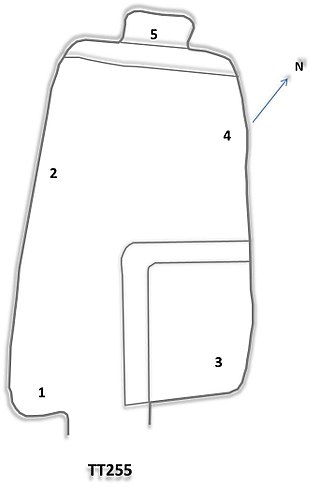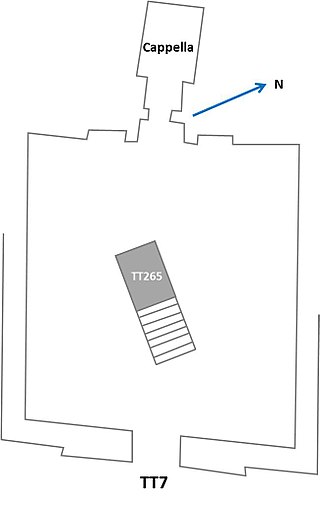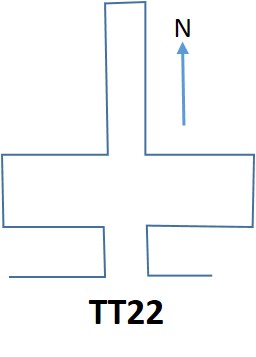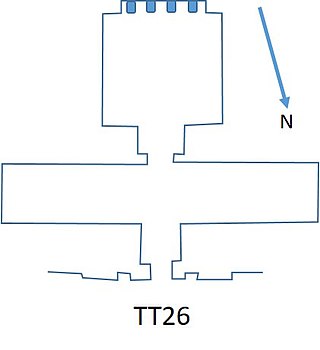
Tomb KV14 is a joint tomb, used originally by Twosret and then reused and extended by Setnakhte. It has been open since antiquity, but was not properly recorded until Hartwig Altenmüller excavated it from 1983 to 1987.

Tomb KV61 is an unused tomb in Egypt's Valley of the Kings. It was discovered by Harold Jones, excavating on behalf of Theodore M. Davis, in January 1910. The tomb consists of an irregularly-cut room at the bottom of a shaft. It was apparently unused and undecorated, thus its intended owner is unknown.

The Valley of the Kings, also known as the Valley of the Gates of the Kings, is a valley in Egypt where, for a period of nearly 500 years from the 16th to 11th century BC, rock-cut tombs were excavated for the pharaohs and powerful nobles of the New Kingdom.

The Theban Necropolis is a necropolis on the west bank of the Nile, opposite Thebes (Luxor) in Upper Egypt. It was used for ritual burials for much of the Pharaonic period, especially during the New Kingdom.

Nakht was an ancient Egyptian official who held the position of a scribe and astronomer of Amun, probably during the reign of Thutmose IV of the Eighteenth Dynasty. He was buried in the Theban Necropolis in tomb TT52.

Tomb TT192, located in the necropolis of El-Assasif in Thebes, Egypt, is the tomb of Kheruef, also called Senaa, who was Steward to the Great Royal Wife Tiye, during the reign of Amenhotep III. It is located in El-Assasif, part of the Theban Necropolis.

A necropolis is a large, designed cemetery with elaborate tomb monuments. The name stems from the Ancient Greek νεκρόπολις nekropolis, literally meaning "city of the dead".

The Theban Tomb TT255 is located in Dra' Abu el-Naga'. It forms part of the Theban Necropolis, situated on the west bank of the Nile opposite Luxor. The sepulchre is the burial place of the ancient Egyptian Roy, who lived at the end of the 18th Dynasty, during the reign of Horemheb.

The Theban Tomb TT7 is located in Deir el-Medina, part of the Theban Necropolis, on the west bank of the Nile, opposite to Luxor. It is the burial place of the ancient Egyptian artisan named Ramose, who lived during the 19th Dynasty, during the reign of Ramesses II.

The Theban Tomb TT56 is located in Sheikh Abd el-Qurna. It forms part of the Theban Necropolis, situated on the west bank of the Nile opposite Luxor. The tomb is the burial place of the ancient Egyptian official Userhat, who was the Royal Scribe, Child of the Royal Nursery, during the 18th Dynasty king Amenhotep II and his wife Mutnefret. TT56 is one of the best preserved Theban nobility tombs from Western Thebes and its paintings boast many vivid and brightly painted scenes depicting the deceased Userhat and Mutnefret receiving gifts and presents in the afterlife.
Nebetnehat was an ancient Egyptian queen consort during the mid-18th Dynasty. She was the Great Royal Wife of an unidentified pharaoh. Her name is only known from an alabaster canopic fragment found in the valley of the Queens. The canopic jar was part of a find referred to as the Tomb of the Princesses.

The Theban Tomb TT13 is located in Dra' Abu el-Naga', part of the Theban Necropolis, on the west bank of the Nile, opposite to Luxor. It is the burial place of the ancient Egyptian Shuroy, who was Head of Brazier-bearers of Amun.

The Theban Tomb TT18 is located in Dra' Abu el-Naga', part of the Theban Necropolis, on the west bank of the Nile, opposite to Luxor. It is the burial place of the ancient Egyptian Baki, who was Chief Weigher of the Gold of Amun during the early Eighteenth Dynasty.

The Theban Tomb TT22 is located in Sheikh Abd el-Qurna, part of the Theban Necropolis, on the west bank of the Nile, opposite to Luxor. It is the burial place of the ancient Egyptian Wah, who was royal butler during the early Eighteenth Dynasty.
The Theban Tomb TT23 is located in Sheikh Abd el-Qurna, part of the Theban Necropolis, on the west bank of the Nile, opposite to Luxor. It is the burial place of the ancient Egyptian official, Tjay or Thay called To, who was a royal scribe of the dispatches of the Lord of the Two Lands, during the 19th Dynasty. Thay served during the reign of Merenptah.

The Theban Tomb TT26 is located in El-Assasif, part of the Theban Necropolis, on the west bank of the Nile, opposite to Luxor. It is the burial place of the ancient Egyptian official, Khnumemhab.
The Theban Tomb TT34 is located in El-Assasif. It forms part of the Theban Necropolis, situated on the west bank of the Nile opposite Luxor. The tomb is the burial place of the ancient Egyptian official, Mentuemhat (Montuemhat).

The Theban Tomb TT171 is located in Sheikh Abd el-Qurna, part of the Theban Necropolis, on the west bank of the Nile, opposite to Luxor. The name of the owner is not known. His wife was named Isis (Aset) according to an inscription on the facade. The tomb dates to the Eighteenth Dynasty of Egypt.

The Theban Tomb TT282 is located in Dra' Abu el-Naga', part of the Theban Necropolis, on the west bank of the Nile, opposite to Luxor. It is the burial place of the ancient Egyptian Nakhtmin, also called Nakht, who lived during the reign of Ramesses II of the 19th Dynasty.
















